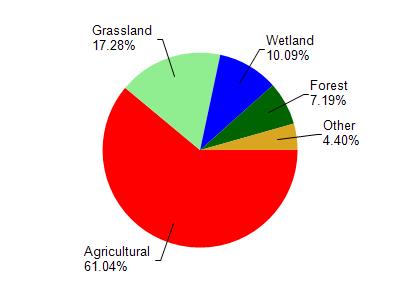Kewaunee
Yes
Yes
No
Fish and Aquatic Life
Overview
Little Scarboro Creek is a cold water, high gradient stream that originates in the Lipsky Swamp and flows 1.5 miles to the Kewaunee River. The East Branch also is a high gradient, coldwater stream that originates in the swamp and enters Little Scarboro Creek near its mouth. Little Scarboro Creek is one of the most productive Class I trout streams in northeastern Wisconsin. It is the only Lake Michigan tributary in Wisconsin with significant natural reproduction of coho salmon and rainbow trout. Brook trout also reproduce in the creek. Public access is excellent, with 432 acres of the Little Scarboro State Public Fishing Area bordering the 1.4 miles of the creek. Aquatic insects collected from Little Scarboro Creek indicate excellent water quality.
Date 2001
Author Michael Toneys
Condition
Wisconsin has over 84,000 miles of streams, 15,000 lakes and milllions of acres of wetlands. Assessing the condition of this vast amount of water is challenging. The state's water monitoring program uses a media-based, cross-program approach to analyze water condition. An updated monitoring strategy (2015-2020) is now available. Compliance with Clean Water Act fishable, swimmable standards are located in the Executive Summary of Water Condition in 2018. See also the 'monitoring and projects' tab.
Reports
Management Goals
Wisconsin's Water Quality Standards provide qualitative and quantitative goals for waters that are protective of Fishable, Swimmable conditions [Learn more]. Waters that do not meet water quality standards are considered impaired and restoration actions are planned and carried out until the water is once again fishable and swimmable
Management goals can include creation or implementation of a Total Maximum Daily Load analysis, a Nine Key Element Plan, or other restoration work, education and outreach and more. If specific recommendations exist for this water, they will be displayed below online.
Monitoring
Monitoring the condition of a river, stream, or lake includes gathering physical, chemical, biological, and habitat data. Comprehensive studies often gather all these parameters in great detail, while lighter assessment events will involve sampling physical, chemical and biological data such as macroinvertebrates. Aquatic macroinvertebrates and fish communities integrate watershed or catchment condition, providing great insight into overall ecosystem health. Chemical and habitat parameters tell researchers more about human induced problems including contaminated runoff, point source dischargers, or habitat issues that foster or limit the potential of aquatic communities to thrive in a given area. Wisconsin's Water Monitoring Strategy was recenty updated.
Grants and Management Projects
| Project Name (Click for Details) | Year Started |
|---|
|
|
Monitoring Projects
| WBIC | Official Waterbody Name | Station ID | Station Name | Earliest Fieldwork Date | Latest Fieldwork Date | View Station | View Data |
|---|
| 90800 | Little Scarboro Creek | 10029270 | Little Scarbro Creek near confluence wth Kewaunee R. | 1/1/2015 | 1/1/2015 | Map | Data |
| 90800 | Little Scarboro Creek | 313169 | Little Scarboro Creek at Cth A | | | Map | Data |
| 90800 | Little Scarboro Creek | 10007957 | Little Scarboro Creek 1 (Cth A) | 10/26/1978 | 10/4/2018 | Map | Data |
|

Watershed Characteristics
Little Scarboro Creek is located in the Kewaunee River watershed which is 142.12 mi². Land use in the watershed is primarily agricultural (61.10%), grassland (17.30%) and a mix of wetland (10.10%) and other uses (11.60%). This watershed has 292.03 stream miles, 540.90 lake acres and 7,312.87 wetland acres.
Nonpoint Source Characteristics
This watershed is ranked High for runoff impacts on streams, Not Ranked for runoff impacts on lakes and High for runoff impacts on groundwater and therefore has an overall rank of High. This value can be used in ranking the watershed or individual waterbodies for grant funding under state and county programs.However, all waters are affected by diffuse pollutant sources regardless of initial water quality. Applications for specific runoff projects under state or county grant programs may be pursued. For more information, go to surface water program grants.